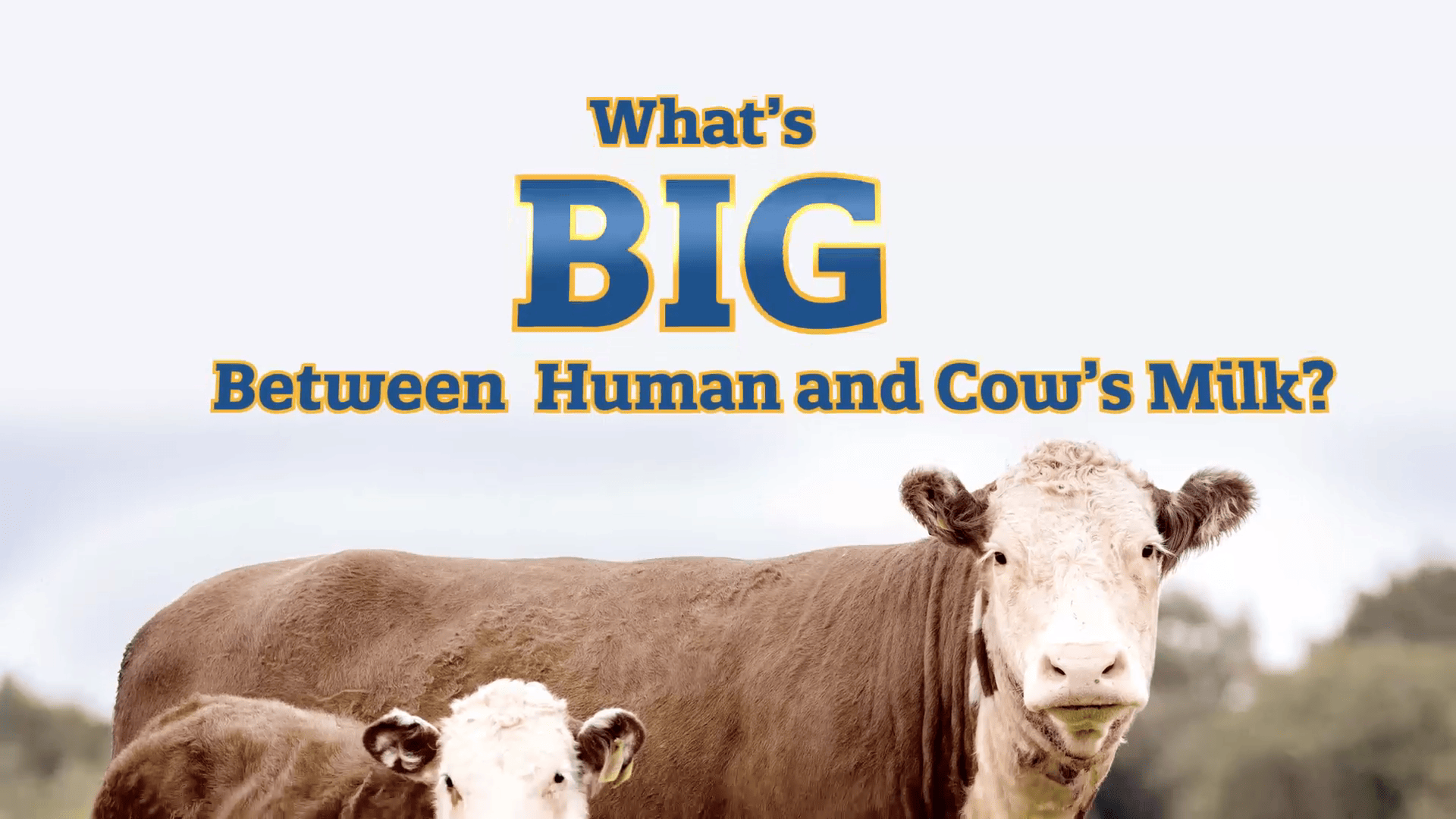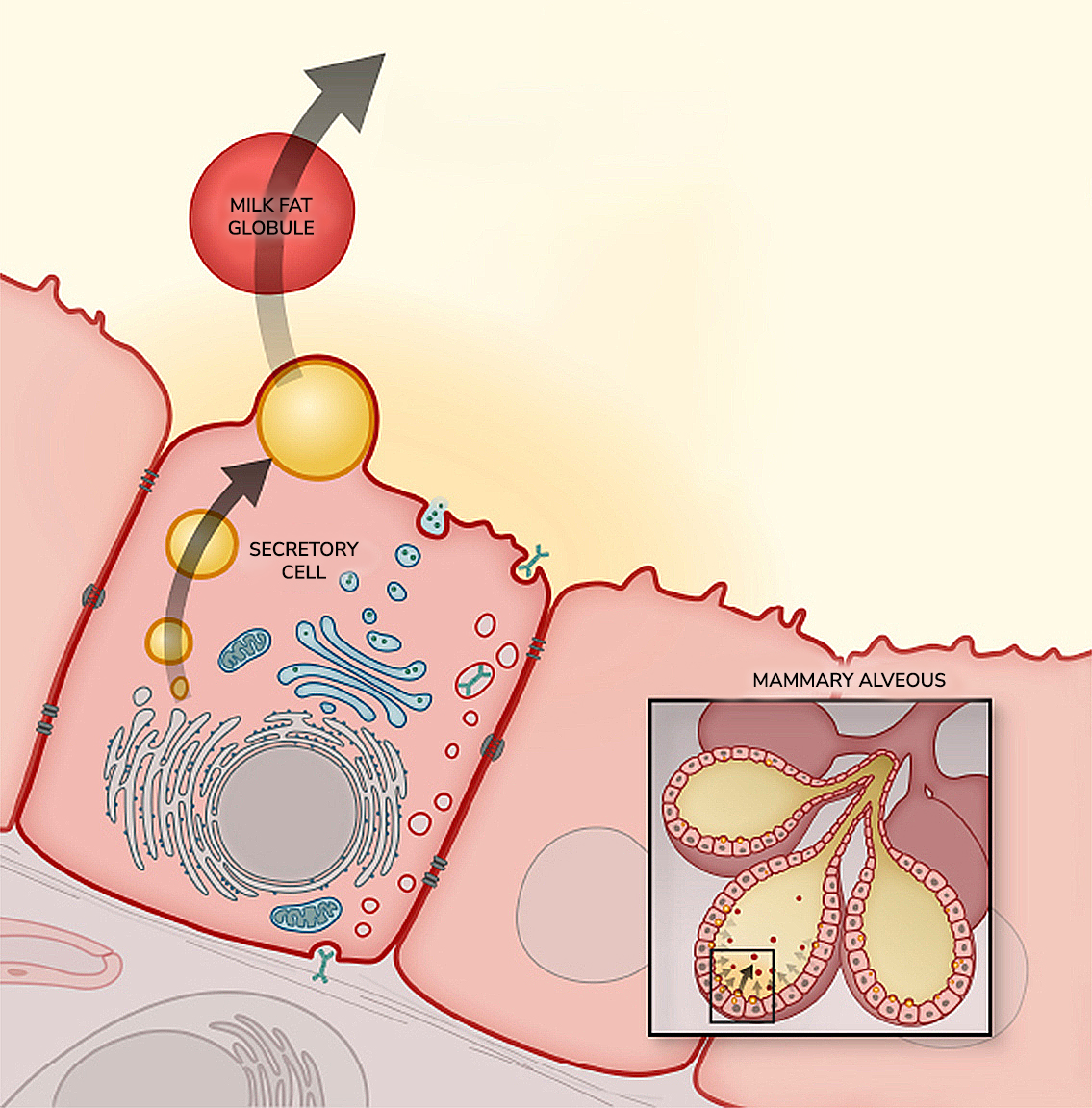Key Points
-
MFGM is naturally occurring in mammalian milk such as human breastmilk and cow’s milk
-
Traditionally, treated fresh milk and milk formulas for consumption have very low levels of MFGM
-
MFGM-enriched ingredients could be generated and used to supplement milk formulas
MFGM is naturally occurring in mammalian milk such as human breastmilk and cow’s milk.1,2
Milk fats are secreted as milk fat globules by lactating cells found in lactating mammary glands in mammals, including humans.
It all starts with the synthesis of triacylglycerols within the endoplasmic reticulum in the lactating cells. Triacylglycerols is a major component of mammalian milk fat and is a major source of energy. The triacylglycerols accumulate in droplets between the inner and outer phospholipid monolayers of the endoplasmic reticulum membrane.
As these droplets increase in size, the two monolayers separate further and eventually pinch off, surrounding the droplet in a phospholipid monolayer vesicle that allows it to disperse within the aqueous cytoplasm of the lactating cell.
The fat droplets then migrate to the apical surface of the lactating cell, where its bilayer plasma membrane subsequently envelops the droplet and extrudes together with it, fully encasing the fat droplet in an additional bilayer of membrane.
The milk fat globule thus released as part of the secreting fluid into the glandular lumen is surrounded by a trilayer membrane containing associated proteins, carbohydrates, and lipids derived primarily from the membrane of the secreting lactating cell. This trilayer is collectively known as MFGM.
MFGM, by acting as an emulsion, allows triacylglycerols to be transferred to milk in a homogenous solution, and also provides health benefits through its various components.1,2
The milk fat globule measures 3-6 μm in average diameter.
Traditionally, treated fresh milk and milk formulas for consumption have very low levels of MFGM.3
Raw milk – untreated whole milk directly from its natural source – is usually pasteurized and homogenized as part of the process to make available fresh milk and milk formulas for consumption.
While pasteurization involves heating the raw milk to kill pathogens, homogenization involves breaking down the fat globules so that they can be dispersed evenly to achieve the same consistency throughout the final milk product. During such pasteurization and homogenization, MFGM is disrupted and hence lost in the milk preparation.
Moreover, vegetable oils rather than mammalian fats are ingredients typically used as the major source of fat in milk formulas. As MFGM originates only in mammalian milk fats, the use of vegetable oils has traditionally resulted in low levels of MFGM in infant milk formulas.
MFGM-enriched ingredients could be generated and used as supplements4,5
Recent technological advances have enabled MFGM-enriched ingredients to be generated on a commercial scale and used as supplements for milk formulas or other MFGM-enriched products.
Among the mammalian milks, cow’s whole milk is commonly used to generate MFGM-enriched ingredients for supplementation in milk formulas because the amounts of MFGM components in cow’s milk are generally comparable with those in human breastmilk with minor differences reported.6
MFGM-enriched ingredients include whey protein isolates, buttermilk and beta serum. These are byproducts generated from the manufacture, using whole milk, of cheese, butter and anhydrous milk fat respectively. These MFGM-enriched ingredients are used in the manufacture of MFGM-supplemented milk formulas.
Production of MFGM-enriched Powdered Ingredients (adapted from Fontecha et al, 2020 and Raza et al, 2021)

MFGM-supplemented milk formulas are now available.

Commercially available MFGM-supplemented products largely come in the form of MFGM-supplemented milk formulas.
In paediatric MFGM-supplemented milk formulas, the MFGM is typically sourced from bovine-derived MFGM whey or buttermilk.
Adult MFGM-supplemented products currently are commercially available as milk formulas and snack bars. Pill forms are currently available for research and have yet to be commercially available.
References
- Silva RCD, Colleran HL, Ibrahim SA. Milk fat globule membrane in infant nutrition: a dairy industry perspective. J Dairy Res. 2021 Feb;88(1):105-116.
- Brink LR, Lönnerdal B. Milk fat globule membrane: the role of its various components in infant health and development. J Nutr Biochem. 2020 Nov;85:108465.
- Lopez C, Cauty C, Guyomarc’h F. Organization of lipids in milks, infant milk formulas and various dairy products: role of technological processes and potential impacts. Dairy Sci Technol. 2015;95(6):863-893.
- Fontecha J, Brink L, Wu S, Pouliot Y, Visioli F, Jiménez-Flores R. Sources, Production, and Clinical Treatments of Milk Fat Globule Membrane for Infant Nutrition and Well-Being. Nutrients. 2020 May 30;12(6):1607.
- Raza GS, Herzig KH, Leppäluoto J. Invited review: Milk fat globule membrane-A possible panacea for neurodevelopment, infections, cardiometabolic diseases, and frailty. J Dairy Sci. 2021 Jul;104(7):7345-7363.
- Kosmerl E, Rocha-Mendoza D, Ortega-Anaya J, Jiménez-Flores R, García-Cano I. Improving Human Health with Milk Fat Globule Membrane, Lactic Acid Bacteria, and Bifidobacteria. Microorganisms. 2021 Feb 9;9(2):341.
- Silva RCD, Colleran HL, Ibrahim SA. Milk fat globule membrane in infant nutrition: a dairy industry perspective. J Dairy Res. 2021 Feb;88(1):105-116.
- Brink LR, Lönnerdal B. Milk fat globule membrane: the role of its various components in infant health and development. J Nutr Biochem. 2020 Nov;85:108465.
- Lopez C, Cauty C, Guyomarc’h F. Organization of lipids in milks, infant milk formulas and various dairy products: role of technological processes and potential impacts. Dairy Sci Technol. 2015;95(6):863-893.
- Fontecha J, Brink L, Wu S, Pouliot Y, Visioli F, Jiménez-Flores R. Sources, Production, and Clinical Treatments of Milk Fat Globule Membrane for Infant Nutrition and Well-Being. Nutrients. 2020 May 30;12(6):1607.
- Raza GS, Herzig KH, Leppäluoto J. Invited review: Milk fat globule membrane-A possible panacea for neurodevelopment, infections, cardiometabolic diseases, and frailty. J Dairy Sci. 2021 Jul;104(7):7345-7363.
- Kosmerl E, Rocha-Mendoza D, Ortega-Anaya J, Jiménez-Flores R, García-Cano I. Improving Human Health with Milk Fat Globule Membrane, Lactic Acid Bacteria, and Bifidobacteria. Microorganisms. 2021 Feb 9;9(2):341.





